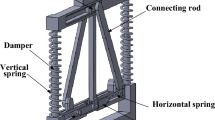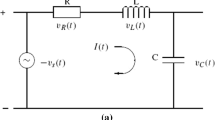Abstract
In this article, the synchronization problem of hyperchaotic systems is addressed on the basis of active sliding mode control (SMC) and proportional integral (PI) SMC techniques. The stability analysis in the suggested methodologies is derived with the help of Lyapunov stability approach. In the manuscript, a comparative study presenting both above mentioned SMC approaches has been presented. Further, both the SMC techniques have been stretched to analyze secure communication for hyperchaotic systems under consideration. Switching surfaces are constructed using active SMC and PI SMC to achieve the purpose of synchronization. Between both the control techniques, PI switching surface simplifies the operation of synchronization in comparison with active control switching surface. In PI SMC, lesser number of control signals are needed to achieve the desired synchronization. The system parameters have been considered to be known. In a master–slave arrangement, the suggested controllers assure the presence of sliding motion and attain asymptotic synchronization of hyperchaotic systems. Ultimately, numerical simulations are produced to establish and authenticate the suggested controllers’ effectiveness. This paper presents the effectiveness of the two control approaches designed for addressing synchronization problems along with secure communication scheme.
















Similar content being viewed by others
References
Al-Obeidi, A. S., & Al-Azzawi, S. F. (2019). Projective synchronization for a class of 6-d hyperchaotic Lorenz system. Indonesian Journal of Electrical Engineering and Computer Science, 16(2), 692–700.
Al-Talib, Z. S., & Al-Azzawi, S. F. (2020). Projective and hybrid projective synchronization of 4-d hyperchaotic system via nonlinear controller strategy. TELKOMNIKA (Telecommunication Computing Electronics and Control), 18(2), 1012–1020.
Bai, E.-W., & Lonngren, K. E. (1997). Synchronization of two Lorenz systems using active control. Chaos, Solitons & Fractals, 8(1), 51–58.
Bai, E.-W., & Lonngren, K. E. (2000). Sequential synchronization of two Lorenz systems using active control. Chaos, Solitons & Fractals, 11(7), 1041–1044.
Blasius, B., Huppert, A., & Stone, L. (1999). Complex dynamics and phase synchronization in spatially extended ecological systems. Nature, 399(6734), 354–359.
Cai, N., Jing, Y., & Zhang, S. (2010). Modified projective synchronization of chaotic systems with disturbances via active sliding mode control. Communications in Nonlinear Science and Numerical Simulation, 15(6), 1613–1620.
Chen, G., & Dong, X. (1993). On feedback control of chaotic continuous-time systems. IEEE Transactions on Circuits and Systems I: Fundamental Theory and Applications, 40(9), 591–601.
Chen, H.-K. (2005). Global chaos synchronization of new chaotic systems via nonlinear control. Chaos, Solitons & Fractals, 23(4), 1245–1251.
Fang, J., Gao, W., & Deng, W. (2015). Synchronization of uncertain chaos system with time delay via hybrid feedback control. In 2015 IEEE international conference on cyber technology in automation, control, and intelligent systems (cyber) (pp. 1959–1964).
Fang, J.-S., Tsai, J.S.-H., Yan, J.-J., Chiang, L.-H., & Guo, S.-M. (2022). Secure data transmission and image encryption based on a digital-redesign sliding mode chaos synchronization. Mathematics, 10(3), 518.
Haeri, M., & Emadzadeh, A. A. (2007). Synchronizing different chaotic systems using active sliding mode control. Chaos, Solitons & Fractals, 31(1), 119–129.
Han, S. K., Kurrer, C., & Kuramoto, Y. (1995). Dephasing and bursting in coupled neural oscillators. Physical Review Letters, 75(17), 3190.
Ho, M.-C., & Hung, Y.-C. (2002). Synchronization of two different systems by using generalized active control. Physics Letters A, 301(5–6), 424–428.
Huang, L., Feng, R., & Wang, M. (2004). Synchronization of chaotic systems via nonlinear control. Physics Letters A, 320(4), 271–275.
Jahanshahi, H., Yousefpour, A., Wei, Z., Alcaraz, R., & Bekiros, S. (2019). A financial hyperchaotic system with coexisting attractors: Dynamic investigation, entropy analysis, control and synchronization. Chaos, Solitons & Fractals, 126, 66–77.
Jang, M.-J., Chen, C.-L., et al. (2002). Sliding mode control of hyperchaos in Rössler systems. Chaos, Solitons & Fractals, 14(9), 1465–1476.
Jia, Q. (2007). Adaptive control and synchronization of a new hyperchaotic system with unknown parameters. Physics Letters A, 362(5–6), 424–429.
Karimov, T., Rybin, V., Kolev, G., Rodionova, E., & Butusov, D. (2021). Chaotic communication system with symmetry-based modulation. Applied Sciences, 11(8), 3698.
Kocarev, L., & Parlitz, U. (1995). General approach for chaotic synchronization with applications to communication. Physical Review Letters, 74(25), 5028.
Kwok, H. S., Tang, W. K., & Man, K.-F. (2004). Online secure chatting system using discrete chaotic map. International Journal of Bifurcation and Chaos, 14(01), 285–292.
Li, X.-B., Wang, Q.-S., Yao, J.-R., & Zhao, G.-Y. (2008). Chaotic time series prediction for surrounding rock’s deformation of deep mine lanes in soft rock. Journal of Central South University of Technology, 15(2), 224–229.
Merat, K., Sadeghian, H., Salarieh, H., & Alasty, A. (2007). Chaos control of a sprott circuit using delayed feedback control: Experimental study. In 2007 IEEE/ASME international conference on advanced intelligent mechatronics (pp. 1–4).
Murali, K., & Lakshmanan, M. (2003). Secure communication using a compound signal using sampled-data feedback. Applied Mathematics and Mechanics, 11, 1309–1315.
Nepomuceno, E. G., & Mendes, E. M. (2017). On the analysis of pseudo-orbits of continuous chaotic nonlinear systems simulated using discretization schemes in a digital computer. Chaos, Solitons & Fractals, 95, 21–32.
Ott, E., Grebogi, C., & Yorke, J. A. (1990). Controlling chaos. Physical Review Letters, 64(11), 1196.
Pallav, & Handa, H. (2021). Active control synchronization of similar and dissimilar chaotic systems. In 2021 Innovations in power and advanced computing technologies (i-pact) (pp. 1–6).
Pallav, & Handa, H. (2022). Simple synchronization scheme for a class of nonlinear chaotic systems using a single input control. IETE Journal of Research, 1–14.
Pecora, L. M., & Carroll, T. L. (1990). Synchronization in chaotic systems. Physical Review Letters, 64(8), 821.
Roopaei, M., Zolghadri, M., & Meshksar, S. (2009a). Enhanced adaptive fuzzy sliding mode control for uncertain nonlinear systems. Communications in Nonlinear Science and Numerical Simulation, 14(9–10), 3670–3681.
Roopaei, M., & Zolghadri Jahromi, M. (2008). Synchronization of two different chaotic systems using novel adaptive fuzzy sliding mode control. Chaos: An Interdisciplinary Journal of Nonlinear Science, 18(3), 033133.
Roopaei, M., Zolghadri Jahromi, M., & Jafari, S. (2009b). Adaptive gain fuzzy sliding mode control for the synchronization of nonlinear chaotic gyros. Chaos: An Interdisciplinary Journal of Nonlinear Science, 19(1), 013125.
Tl, C., & Lm, P. (1991). Synchronizing chaotic circuits. IEEE Transactions on Circuits and Systems, 38(4), 453–456.
Tutueva, A. V., Moysis, L., Rybin, V. G., Kopets, E. E., Volos, C., & Butusov, D. N. (2022). Fast synchronization of symmetric Hénon maps using adaptive symmetry control. Chaos, Solitons & Fractals, 155, 111732.
Vaidyanathan, S., & Sampath, S. (2011). Global chaos synchronization of hyperchaotic Lorenz systems by sliding mode control. In International conference on digital image processing and information technology (pp. 156–164).
Wang, X., & Wang, M. (2008). A hyperchaos generated from Lorenz system. Physica A: Statistical Mechanics and its Applications, 387(14), 3751–3758.
Yan, J.-J., Yang, Y.-S., Chiang, T.-Y., & Chen, C.-Y. (2007). Robust synchronization of unified chaotic systems via sliding mode control. Chaos, Solitons & Fractals, 34(3), 947–954.
Yan, S., Qian, C., Huang, T., & Lin, W. (2014). Synchronization via sampled-data outputfeedback for a class of chaotic systems. In 53rd IEEE conference on decision and control (pp. 2322–2327).
Yin, X., Ren, Y., & Shan, X. (2002). Synchronization of discrete spatiotemporal chaos by using variable structure control. Chaos, Solitons & Fractals, 14(7), 1077–1082.
Zhang, H., Liao, X., & Yu, J. (2005a). Fuzzy modeling and synchronization of hyperchaotic systems. Chaos, Solitons & Fractals, 26(3), 835–843.
Zhang, H., Ma, X.-K., Li, M., & Zou, J.-L. (2005b). Controlling and tracking hyperchaotic Rössler system via active backstepping design. Chaos, Solitons & Fractals, 26(2), 353–361.
Zhang, H., Ma, X.-K., & Liu, W.-Z. (2004). Synchronization of chaotic systems with parametric uncertainty using active sliding mode control. Chaos, Solitons & Fractals, 21(5), 1249–1257.
Zhao, Y., Zhang, W., Su, H., & Yang, J. (2018). Observer-based synchronization of chaotic systems satisfying incremental quadratic constraints and its application in secure communication. IEEE Transactions on Systems, Man, and Cybernetics: Systems, 50(12), 5221–5232.
Zhou, J., & Wen, C. (2008). Adaptive backstepping control of uncertain systems: Nonsmooth nonlinearities, interactions or timevariations. Springer.
Author information
Authors and Affiliations
Corresponding author
Ethics declarations
Conflict of interest
The authors declare that they have no conflict of interest.
Additional information
Publisher's Note
Springer Nature remains neutral with regard to jurisdictional claims in published maps and institutional affiliations.
Rights and permissions
Springer Nature or its licensor holds exclusive rights to this article under a publishing agreement with the author(s) or other rightsholder(s); author self-archiving of the accepted manuscript version of this article is solely governed by the terms of such publishing agreement and applicable law.
About this article
Cite this article
Pallav, Handa, H. Chaos Synchronization for a Class of Hyperchaotic Systems Using Active SMC and PI SMC : A Comparative Analysis. J Control Autom Electr Syst 33, 1671–1687 (2022). https://doi.org/10.1007/s40313-022-00960-9
Received:
Revised:
Accepted:
Published:
Issue Date:
DOI: https://doi.org/10.1007/s40313-022-00960-9




